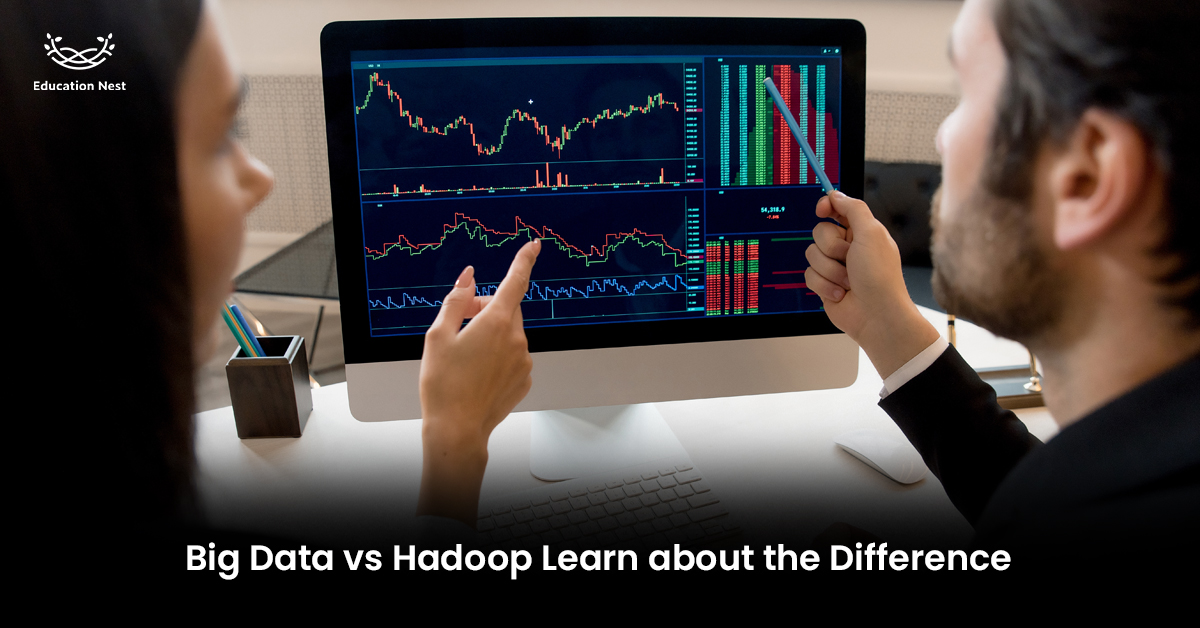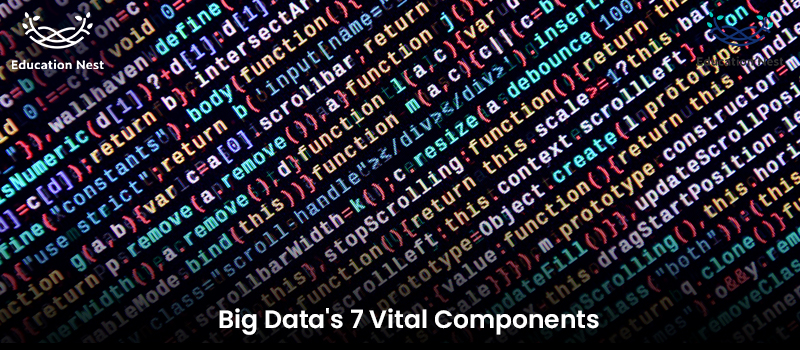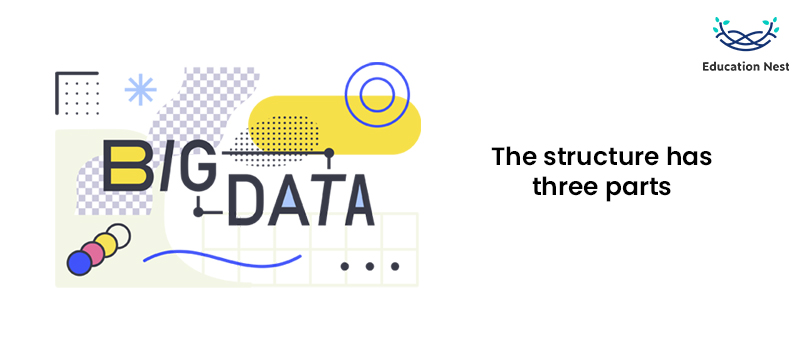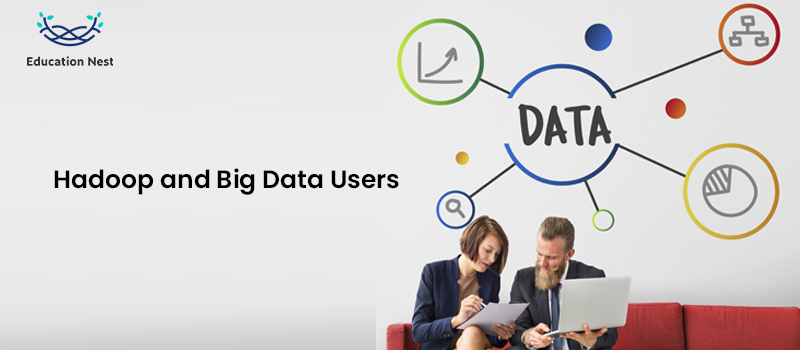
Hadoop and Big Data are undoubtedly two phrases you’ve heard if you work in a business-related field. But to what do they refer? When and why should businesses employ them? All of your questions will be answered in this blog. Additionally, you learn the ins and outs of Hadoop Big Data and how it differs from other types of Big Data.
Do you know what big data and Hadoop are? Let’s take a look.
A Definition of Big Data

Information, both organised and unorganised, is readily accessible on the web. Every day, 2.5 quadrillion bytes of new information are created. “Big Data” describes this vast collection of information. By 2020, each person is expected to generate more than 1.7 gigabytes of data per second.
“Big Data” consists of a compilation of data sets that are so massive and complicated that they are infeasible to handle using conventional data processing software and archival methods. Data visualisation, analysis, transport, publishing, searching, storing, curating, and capturing are just a few of the many complex elements.
You Must Watch: A List of Top Big Data Engineer Skills One Must Possess
The three different forms of Big Data:

Unstructured:
These are unstructured and difficult-to-evaluate data sets. The Schemas of this information are unknown, and it may include things like video or music files, etc.
Semi-Structured:
This is the type of information where some pieces are organised while others are not. There is no standard format for it like JSON, XML, etc.
Structured:
In terms of organisation, these facts are ideal. A database management system (RDBMS) gives the data a consistent structure that makes it easier to analyse and process.
Big Data’s 7 Vital Components:

Variety:
Data in Big Data may come in various forms, including but not limited to emails, remarks, likes, sharing, videos, audio, text, etc.
Velocity:
Data is being made at a dizzying rate, and something new appears every minute of every day. It is estimated that daily video views on Facebook will reach 2.77 million, with users sending an average of 31.25 million messages.
Volume:
Big Data gets its name from the massive amount of information created every hour. Retail giant Walmart, for instance, amassed 2.5 petabytes of client transaction data.
Veracity:
In other words, it measures how reliable Big Data is as a basis for decisions. Big Data cannot always be relied on to provide definitive answers and must be supplemented with other sources of information.
Value:
Big Data doesn’t mean anything on its own if it isn’t handled and analysed, which is what this concept is getting at.
Variability:
It indicates that the meaning of big data is fluid and evolving throughout time; there needs to be a stable interpretation of it.
Visualisation:
It implies that big data is understandable and easily accessible. Because of its massive volume and rapidity, big data is very challenging to interpret and access.
Moving forward, let’s learn what Hadoop is.
Definition of Hadoop
Hadoop is a well-known open-source software framework for large-scale distributed computing on cheap commodity hardware. The MapReduce framework created it, and the Apache v2 licence, which employs functional programming principles, governs its distribution. It is a high-level Apache project written in Java.
The structure has three parts:

HDFS:
A trusted data storage system currently holds more information than any other system on the planet.
MapReduce:
The layer is made up of dispersed processing nodes.
Yarn:
A resource manager makes up the layer.
We will now discuss various ways big data and Hadoop can be differentiated.
What are the differences between Hadoop and Big Data?

Definition:
“Big Data” is a vast volume of data, which may be in either an organised or unstructured form; Hadoop is a type of system that can manage and analyse this massive amount of data.
Developers:
When processing data, big data engineers will only be responsible for writing the programs in Spark, MapReduce, Pig, Hive, etc. In contrast, Hadoop engineers will handle the bulk of the underlying code.
Type:
Hadoop is a solution to the complex challenge of processing big data, which has no meaning or value until it is processed.
Accessibility:
Compared to other solutions, the Hadoop structure makes processing and getting to the data faster. However, getting large amounts of data is still hard.
Storage:
While massive data may be stored in Apache Hadoop HDFS, doing so is challenging since big data can be either unstructured or structured.
Significance:
Hadoop can refine big data’s meaning, but the data is meaningless unless it can be used to provide a financial return.
Veracity:
This metric measures the reliability of the data. Hadoop’s ability to handle and analyse large amounts of data enables improved analysis and decision-making. Big Data has the potential to revolutionise numerous industries, but it also has its limitations when making sound decisions because of the insufficiently organised data it contains. This means that big data can only be relied upon sometimes to provide the best possible outcome.
Hadoop and Big Data Users:

IBM, AOL, Yahoo, Amazon, Facebook, etc., are just a few of the businesses that have used Hadoop. Facebook uses big data to process the 500 TB of data it creates daily, while the airline sector generates 10 TB of information every 30 minutes. About 2.5 quadrillion bytes of data, or 2.5 exabytes, are produced annually around the globe.
Nature:
Big Data refers to massive amounts of information that are diverse, in a hurry, and take up a lot of storage space. Hadoop is a tool, but “big data” is not. The significant distinction between Hadoop and Big Data is that the former is seen as an asset that may be lucrative, while the latter is viewed as a program to extract that value.
Hadoop is built to handle and manage complex and sophisticated big data, whereas big data is unprocessed and raw. Hadoop is merely another technical framework for analysing, storing, and keeping these massive amounts of data in significant numbers. Still, “big data” is primarily a commercial notion denoting a wide variety and quantity of data sets.
Representation:
Hadoop is just one of many frameworks that use big-data processing ideas. Together, these frameworks are called “big data,” which is like an umbrella covering many different technologies.
Speed:
Big Data is quite sluggish, particularly when compared to Hadoop’s speed. Hadoop’s data processing speeds are superior.
The extent of use:
Numerous industry areas, including finance, information technology, the commercial industry, telecom, transportation, and healthcare, make considerable use of Big Data. Hadoop’s core functions are YARN for managing cluster resources, MapReduce for parallelisation, and HDFS for storing data.
Challenges:
Hadoop doesn’t have the same issues that Big Data has, such as protecting Big Data, data processing in massive volumes, and storing data in enormous amounts.
Manageability:
Hadoop is easily managed since it functions like any other programmable tool or software. Big Data, however, is not the easiest to handle, as its very name suggests. This is due to the sheer size and scope of the datasets it contains. Only massive corporations have the workforce and computing power to handle and process this data.
Applications:
Big data can be used for many things, such as weather forecasting, protecting against cyberattacks, Google’s self-driving car, research and science, sensor data, text analytics, fraud detection, sentiment analysis, and so on. Hadoop’s speed and ease of use make it ideal for processing large datasets in real time, which can then be used to inform decisions and enhance operational efficiency.
Finally, we have covered the differences between big data and Hadoop. To sum up, this blog also helped you learn more about big data and Hadoop.

